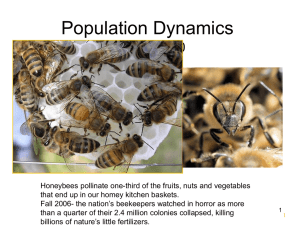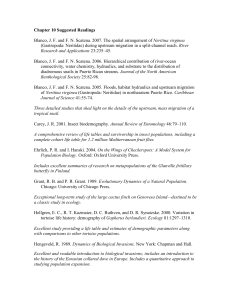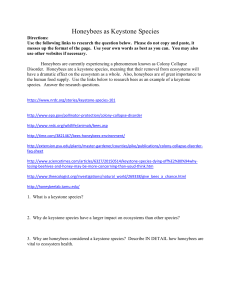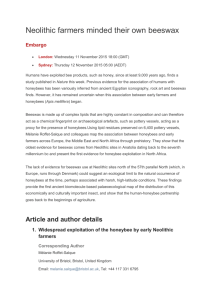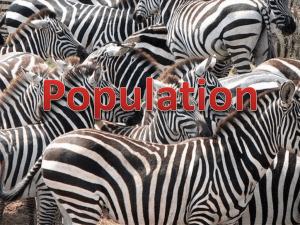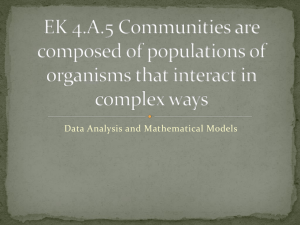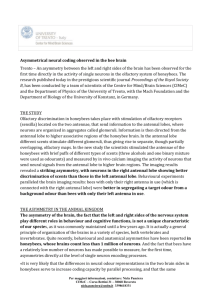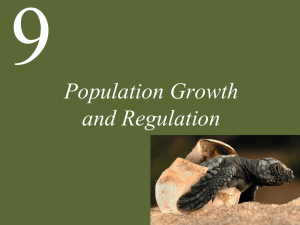Populations Dynamics
advertisement
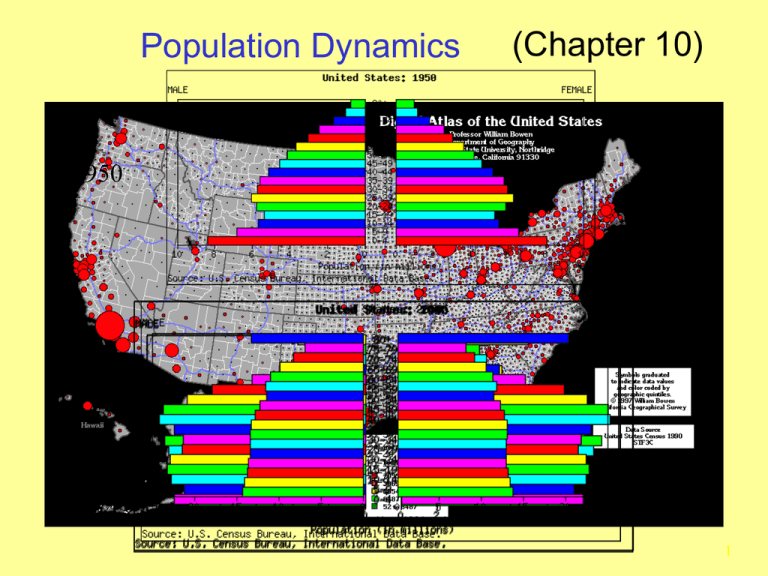
Population Dynamics (Chapter 10) 1950 1 Estimating Patterns of Survival • Three main methods of estimation: Cohort life table Identify individuals born at same time and keep records from birth. Static life table Record age at death of individuals. Age distribution Calculate difference in proportion of individuals in each age class. Assumes differences from mortality. 2 Survivorship Curves • • • Type I: Majority of mortality occurs among older individuals. Dall Sheep Type II: Constant rate of survival throughout lifetime. American Robins Type III: High mortality among young, followed by high survivorship. Sea Turtles 3 4 5 6 7 Age Distribution • Age distribution of a population reflects its history of survival, reproduction, and growth potential. 8 Age Distribution • Rio Grande Cottonwood populations (Populus deltoides wislizenii) are …. 9 Dynamic Population in a Variable Climate • • Grant and Grant studied Galapagos Finches. Responsiveness of population age structure to environmental variation. 10 Blacknose dace (Rhinichthys atratulus) South Branch Codorus Creek D-NFSTP U-NFSTP Blacknose Dace 14 25 12 8 15 6 10 4 5 2 7711 668 9 7 65 6 65 62 M 7 or 3 e Standard length Standard length (mm) 63 6 591 5569 553 7 50 55 53 51 47 4 449 4417 3485 35 43 1 32 4 39 3 297 2365 00 2333 Frequency Frequency 10 20 11 700 Million Years of Eating DNA: A Conserved Competence Regulon in Gamma-Proteobacteria. Dr. Andrew Cameron Microbiology Department University of British Columbia, Vancouver, B.C. Tuesday, March 6th, at 4:30 – 5:30 p.m. Ruhl Student Center, Community Room 12 Rates of Population Change • • • Birth Rate: Number of young born per female; seeds per individual plant. Fecundity Schedule: Tabulation of birth rates for females of different ages. “Life Table” of survivorship per age grouping (see above) combined with fecundity schedule can be used to calculate net reproductive rates. 13 Estimating Rates for an Annual Plant • Phlox drummondii (phlox) Ro = Net reproductive rate; Average number of seeds produced by an individual in a population over lifetime (“birth rate”). Ro=∑ lxmx X= Age interval in days. lx = % pop. surviving to each age (x). mx= Average number seeds produced by each individual in each age category. 14 15 Estimating Rates for an Annual Plant • Because P. drummondii has non-overlapping generations, we can estimate growth rate. Geometric Rate of Increase (λ): λ=N t+1 / Nt N t+1 = Size of population at future time. Nt = Size of population at some earlier time. 16 Estimating Rates when Generations Overlap • Common Mud Turtle (K. subrubrum) About half turtles nest each year. Average generation time: T = ∑ xlxmx / Ro X= Age in years Per Capita Rate of Increase: r = ln Ro / T ln = Base natural logarithms fwie.fw.vt.edu/VHS/Kinosternon_subrubrum.htm 17 10_02.jpg 18 Dispersal • Africanized Honeybees Honeybees (Apis melifera) evolved in Africa and Europe and have since differentiated into many locally adapted subspecies. Africanized honeybees disperse much faster than European honeybees. Within 30 years they occupied most of South America, Mexico, and all of Central America. 19 Africanized Honeybees 20 Collared Doves • Collared Doves, Streptopelia decaocto, spread from Turkey into Europe after 1900. Dispersal began suddenly. Not influenced by humans. Took place in small jumps. 45 km/yr 21 Collared Doves 22 Rapid Changes in Response to Climate Change • Tree species began to spread northward about 16,000 years ago following retreat of glaciers and warming climate. Evidence found in preserved pollen in lake sediments. Movement rate 100 - 400 m/yr. 23 Rapid Changes in Response to Climate Change 24 Dispersal in Response to Changing Food Supply • Holling observed numerical responses to increased prey availability. Increased prey density led to increased density of predators. Birds moved. 25
